Research on Motor Rotor Loss of High-Speed Air Compressor in the Application of Hydrogen Fuel Cell Vehicle
Abstract
:1. Introduction
2. Analytical Calculation of Air Friction Loss
2.1. Cylinder Surface Air Friction Loss
2.2. Disk Surface Air Friction Loss
2.3. Calculation of Air Friction Loss of Air Compressor
3. Simulation Calculation of Electromagnetic Loss
3.1. Maxwell Theoretical Equations
3.2. Basic Assumptions and Model Building
- The core loss model adopted the classical calculation formula and ignored any loss change caused by the stacking times of the stator cores;
- The non-uniformity of the permanent magnet structure and the influence of the motor temperature change on the calculation of the motor loss were not considered in this model;
- To avoid mutual interference between the motion domain and the bearing, the gap between the bearing and the rotating shaft was enlarged to 0.9 mm. The windings were treated as stranded winding, and the effect of skin effect was not considered.
4. Experimental Verification
4.1. Test Method
4.2. Simulation Model Verification
5. Results and Discussion
5.1. Analysis of Air Friction Loss
5.2. Analysis of Electromagnetic Loss Simulation Results
5.3. Overall Analysis of Motor Loss
6. Conclusions
- The air friction loss was solved for different rotating cylinder and disk surfaces of the rotor using analytical method. The distribution of the air friction loss of the rotor was determined, and the magnitude of the total air friction loss was estimated. As the rotation speed increases, the overall loss shows an upward trend, and the air friction loss accounts for about 29% of the total loss.
- The winding ends of the motor are long and asymmetrically distributed, so to fully consider the three-dimensional structure of the motor and more accurately calculate loss, a whole machine model was established. The results for the model matched the experimental results well, indicating that the model has a good accuracy.
- The motor efficiency increases with the increase in the rotation speed, but the absolute value of loss also increases with the increase in the rotation speed. Stator core loss and air friction loss are the main sources of loss, accounting for 55.64% and 29% of the total motor loss, respectively. The electromagnetic loss of the winding, eddy current and other alloys accounts for a relatively small proportion, which is 15% in total.
Author Contributions
Funding
Data Availability Statement
Conflicts of Interest
References
- Zhigang, S.; Baolian, Y. Developing Trend and Present Status of Hydrogen Energy and Fuel Cell Development. Bull. Chin. Acad. Sci. 2019, 34, 469–477. [Google Scholar]
- Penglong, B.; Daobiao, Z.H.; Sichuan, X.; Yu, W. Development status and trend of air compressor in fuel cells vehicle. Chin. J. Power Sources 2016, 8, 1731–1734. [Google Scholar]
- Hongqin, L. Design and Research of High Speed Centrifugal Compressor for Hydrogen Fuel Cell Vehicle. Ph.D. Thesis, Zhejiang University, Hangzhou, China, 2019. [Google Scholar]
- Dong, H.; Kai, Z.; Yanyi, Z.; Xiaobing, W.; Xiang, J.; Renguang, W. Brief Introduction of Technology of Air Compressor for Fuel Cell Vehicles. Automob. Parts 2019, 5. [Google Scholar] [CrossRef]
- Yi, Z. Development status and Trend Analysis of Air Compressor for Fuel Cell Vehicle. Intern. Combust. Engine Parts 2019, 2. [Google Scholar]
- Carlson, E.J.; Kopf, P.; Sinha, J.; Sriramulu, S.; Yang, Y. Cost Analysis of PEM Fuel Cell Systems for Transportation: September 30, 2005; National Renewable Energy Lab. (NREL): Golden, CO, USA, 2005. [Google Scholar]
- Ahluwalia, R.K.; Wang, X.; Kwon, J.; Rousseau, A.; Kalinoski, J.; James, B.; Marcinkoski, J. Performance and cost of automotive fuel cell systems with ultra-low platinum loadings. J. Power Sources 2011, 196, 4619–4630. [Google Scholar] [CrossRef]
- Wan, Y.; Guan, J.; Xu, S. Improved Empirical Parameters Design Method for Centrifugal Compressor in PEM Fuel Cell Vehicle Application. Interntional J. Hydrog. Energy 2017, 42, 5590–5605. [Google Scholar] [CrossRef]
- Venturi, M.; Sang, J.; Knoop, A.; Hornburg, G. Air Supply System for Automotive Fuel Cell Application; SAE Technical Paper SAE 2012 World Congress & Exhibition; Society of Automotive Engineers (SAE): Warrendale, PA, USA, 2012. [Google Scholar]
- Ahluwalia, R.K.; Wang, X. Fuel Cell Systems for Transportation: Status and Trends. J. Power Sources 2008, 177, 167–176. [Google Scholar] [CrossRef]
- Zhao, D.; Daniel, K.; Blunier, B.; Zwyssig, C.; Dou, M.; Miraoui, A. Design and Control of an Ultra High Speed Turbo Compressor for the Air Management of Fuel Cell Systems. In IEEE Transportation Electrification Conference and Expo (ITEC); IEEE: Dearborn, MI, USA, 2012. [Google Scholar]
- Zhao, D.; Blunier, B.; Gao, F.; Dou, M.; Miraoui, A. Control of an Ultra High Speed Centrifugal Compressor for the Air Management of Fuel Cell Systems. IEEE Trans Ind. Appl. 2014, 50, 2225–2234. [Google Scholar] [CrossRef]
- Soong, W.L.; Kliman, G.B.; Johnson, R.N.; White, R.A.; Miller, J.E. Novel high-speed induction motor for a commercial centrifugal compressor. IEEE Trans. Ind. Appl. 2000, 36, 706–713. [Google Scholar] [CrossRef]
- Jang, S.M.; Cho, H.W.; Choi, J.Y.; Park, J.H.; Choi, S.K. Development of high-speed brushless DC motor for turbo-compressor. 2005 Int. Conf. Electr. Mach. Syst. 2005, 2, 877–882. [Google Scholar]
- Baek, C.H.; Shin, H.S.; Choi, J.Y. Iron loss analysis of a concentrated winding type interior permanent magnet synchronous motor with single and dual layer magnet shape. Machines 2021, 9, 74. [Google Scholar] [CrossRef]
- Yang, C.; Zhang, Y.; Qiu, H. Influence of output voltage harmonic of inverter on loss and temperature field of permanent magnet synchronous motor. IEEE Trans. Magn. 2019, 55, 1–5. [Google Scholar] [CrossRef]
- Zhang, Y.; Duan, X.; Guo, Y. Research on loss separation of permanent magnet synchronous motor applied in engineering. Small Spec. Electr. Mach. 2016, 44, 46–49. [Google Scholar]
- Guangwei, L.; Xingang, Z.; Fengge, Z.; Xin, Z.; Wenping, C. Iron Loss and Air Friction Loss for High Speed Permanent Magnet Clow Pole Machines. Trans. China Electrotech. Soc. 2015, 30, 148–154. [Google Scholar]
- Aglen, O. Loss Calculation and Thermal Analysis of a High-Speed Generator. In Proceedings of the IEEE International Electric Machines and Drives Conference, Madison, WI, USA, 1–4 June 2003; pp. 1117–1123. [Google Scholar]
- Junqiang, X.; Fengxiang, W.; Dianhai, Z.; Xiaoguang, K. Research on Rotor Air Friction Loss of High-speed Permanet Magnet Machines. Proc. CSEE 2010, 27, 14–19. [Google Scholar]
- Bilgen, E.; Boulos, R. Functional Dependence of Torque Coefficient of Coaxial Cylinders on Gap Width and Reynolds Numbers. J. Fluids Eng. 1973, 95, 122–126. [Google Scholar] [CrossRef]
- Daily, J.W.; Nece, R.E. Chamber Dimension Effects on Induced Flow and Frictional Resistance of Enclosed Rotating Disks. J. Basic Eng. 1960, 82, 217. [Google Scholar] [CrossRef]
- Chapman, S.J. Electric Machinery Fundamentals; Tsinghua University Press: Beijing, China, 2013. [Google Scholar]
- Bertotti, G. General Properties of Power Losses in Soft Ferromagnetic Materials. IEEE Trans. Magn. 1988, 24, 621–630. [Google Scholar] [CrossRef]
- Bo, Z.; Hongliang, Z. Application of Ansoft 12 in Engineering Electromagnetic Field; China Water & Power Press: Beijing, China, 2010. [Google Scholar]
- Ye, H. Design and Analysis of a 100 kW, 50,000 r/min High Speed Permanent Magnet Synchronous Machine. Ph.D. Thesis, Shenyang University of Technology, Shenyang, China, 2017. [Google Scholar]
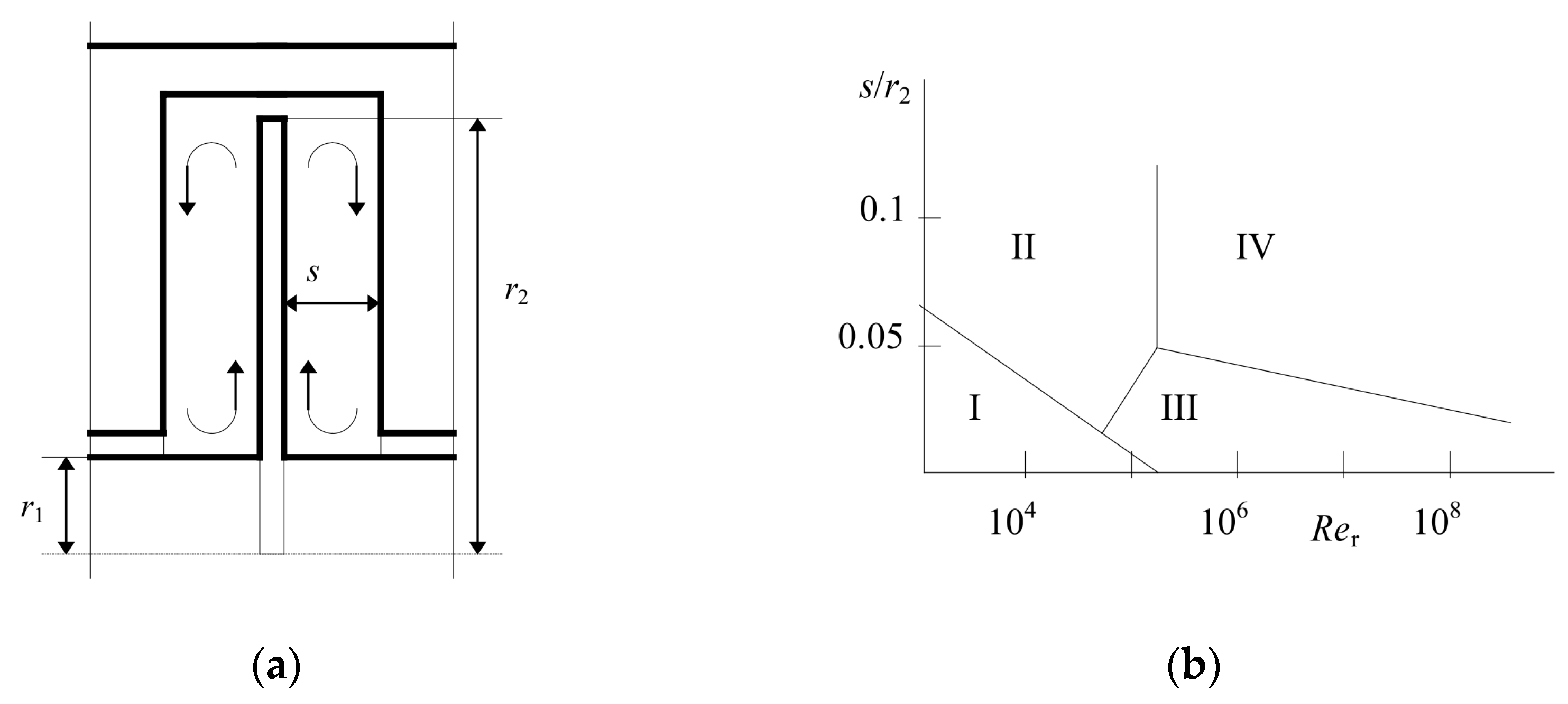
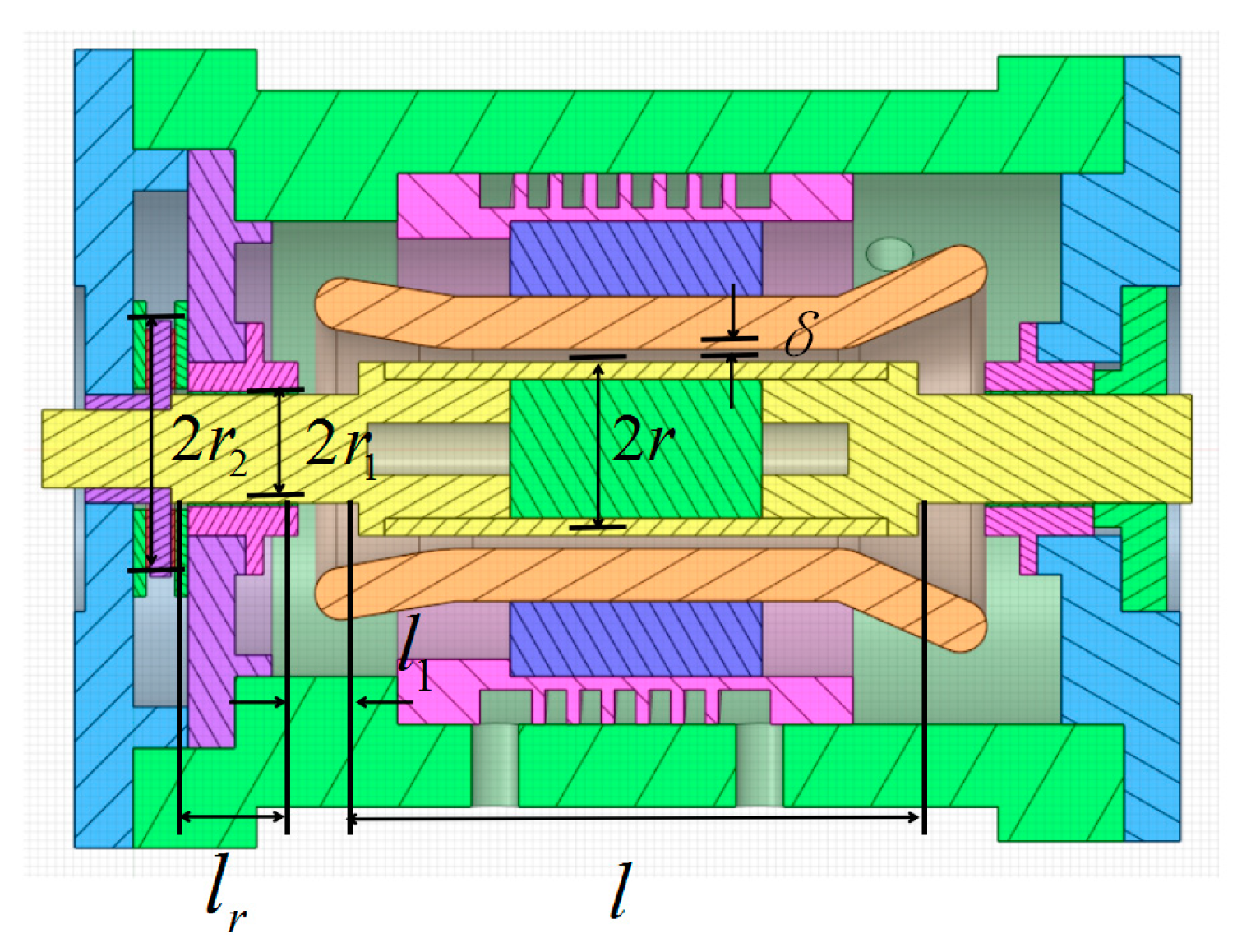


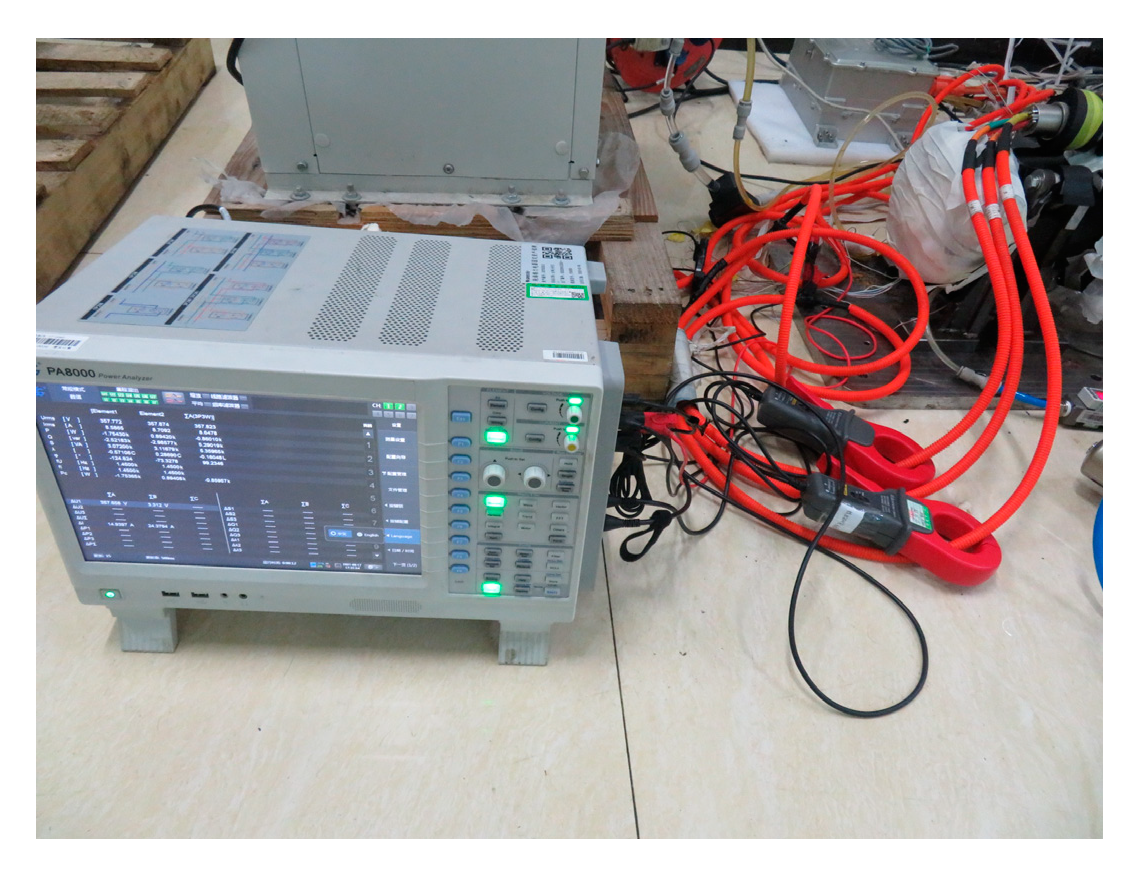
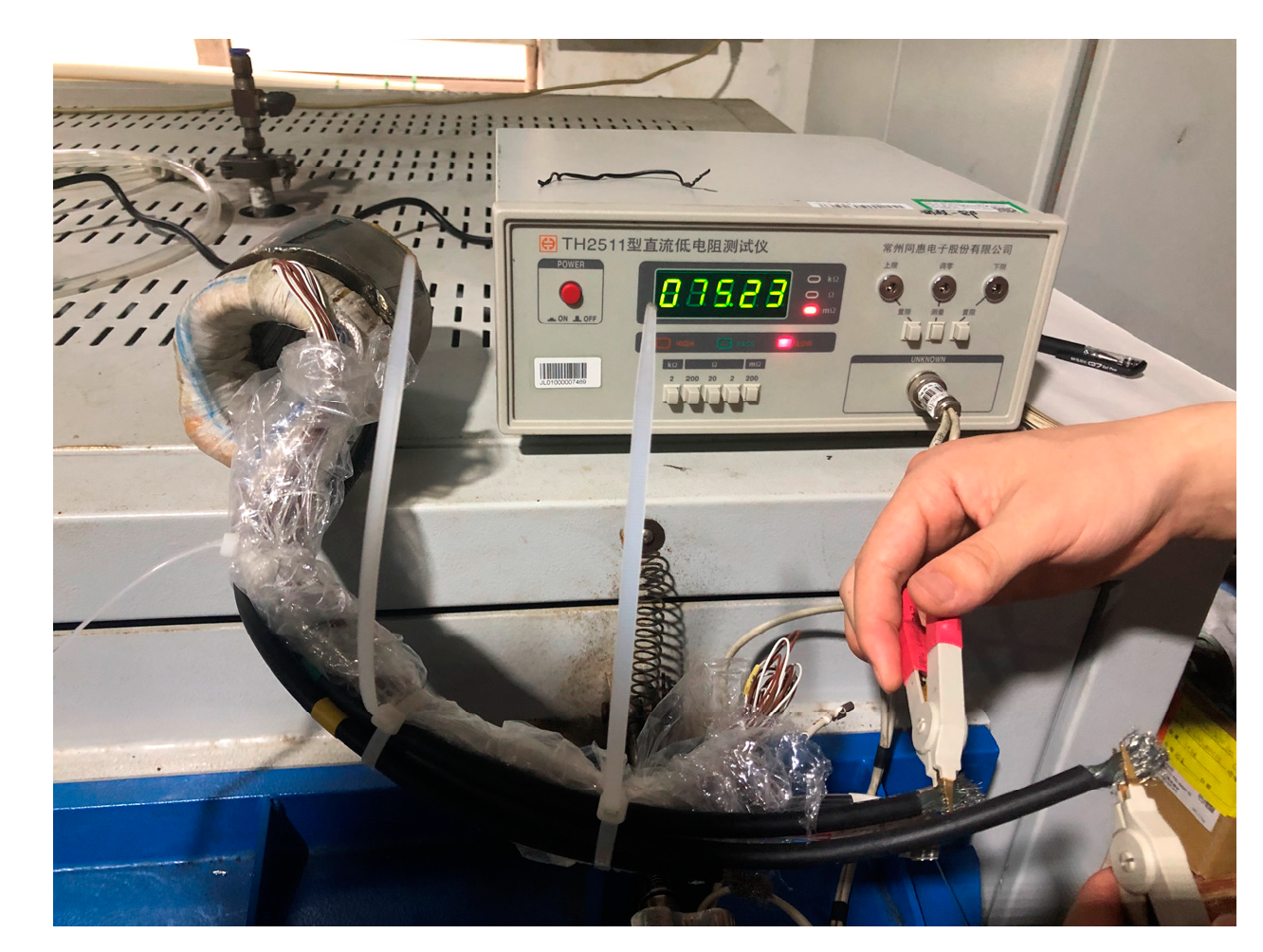

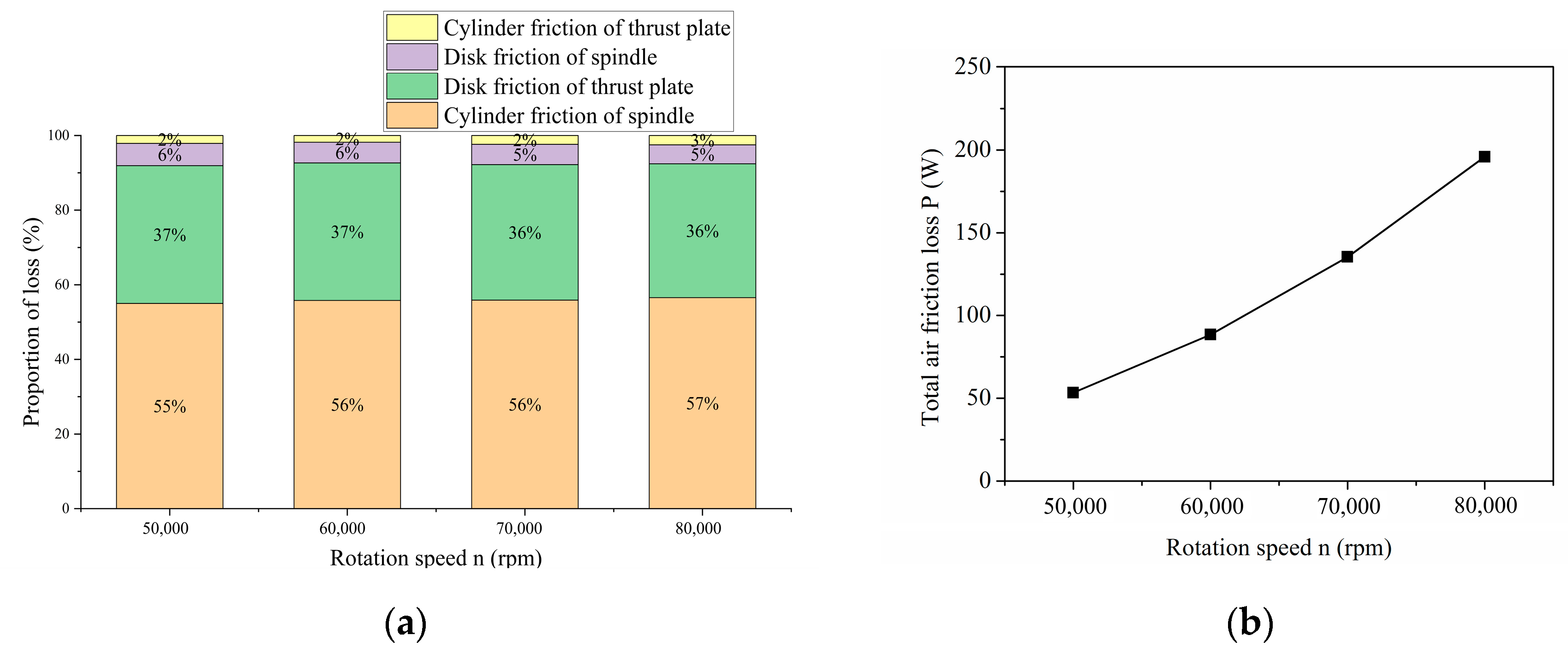
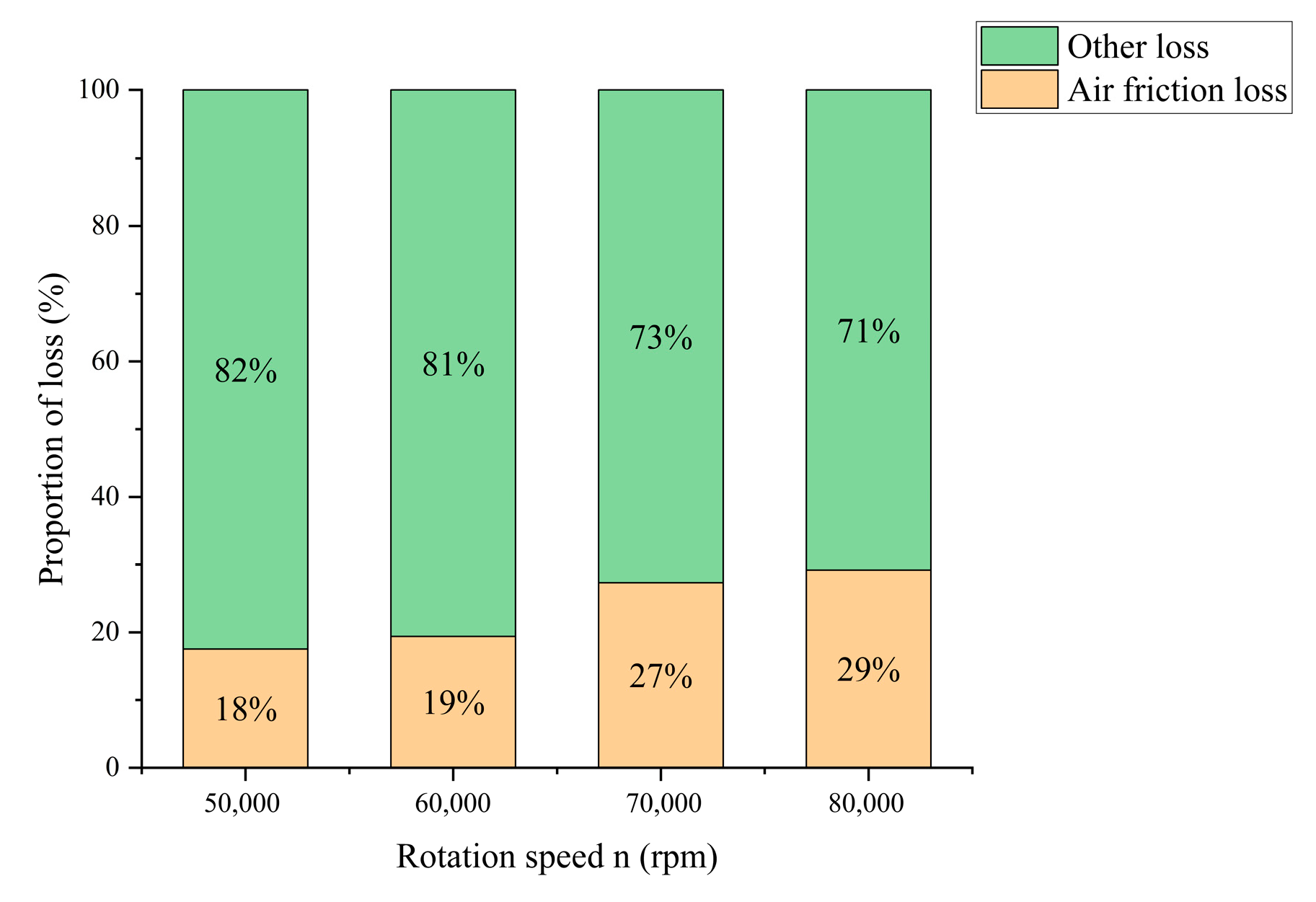
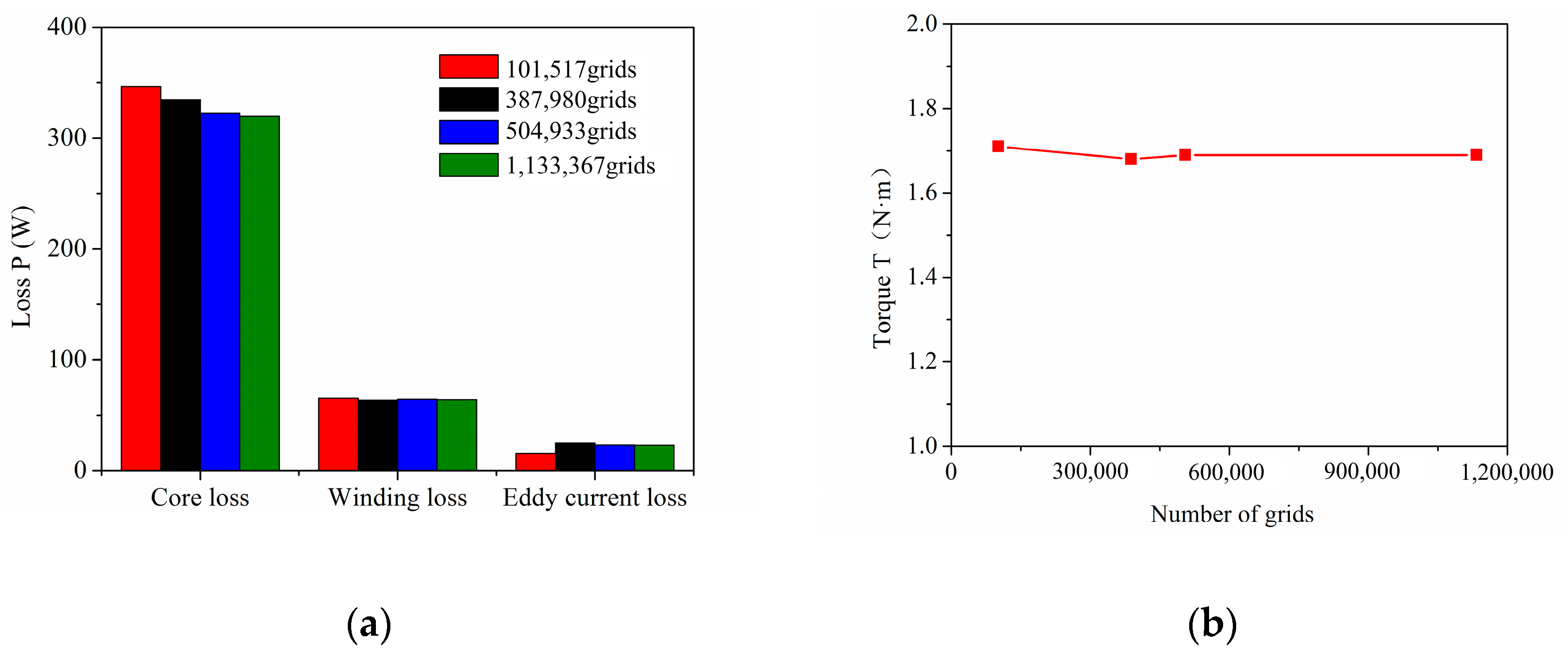
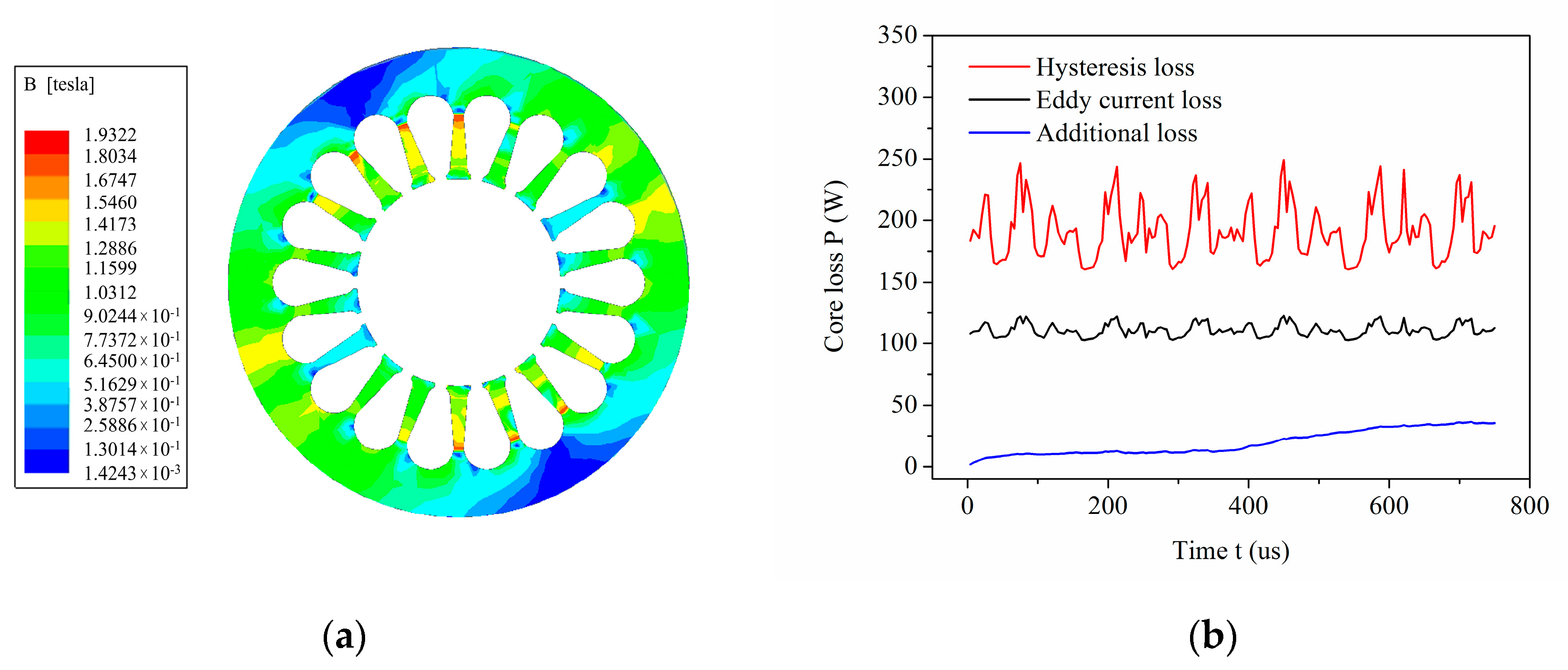
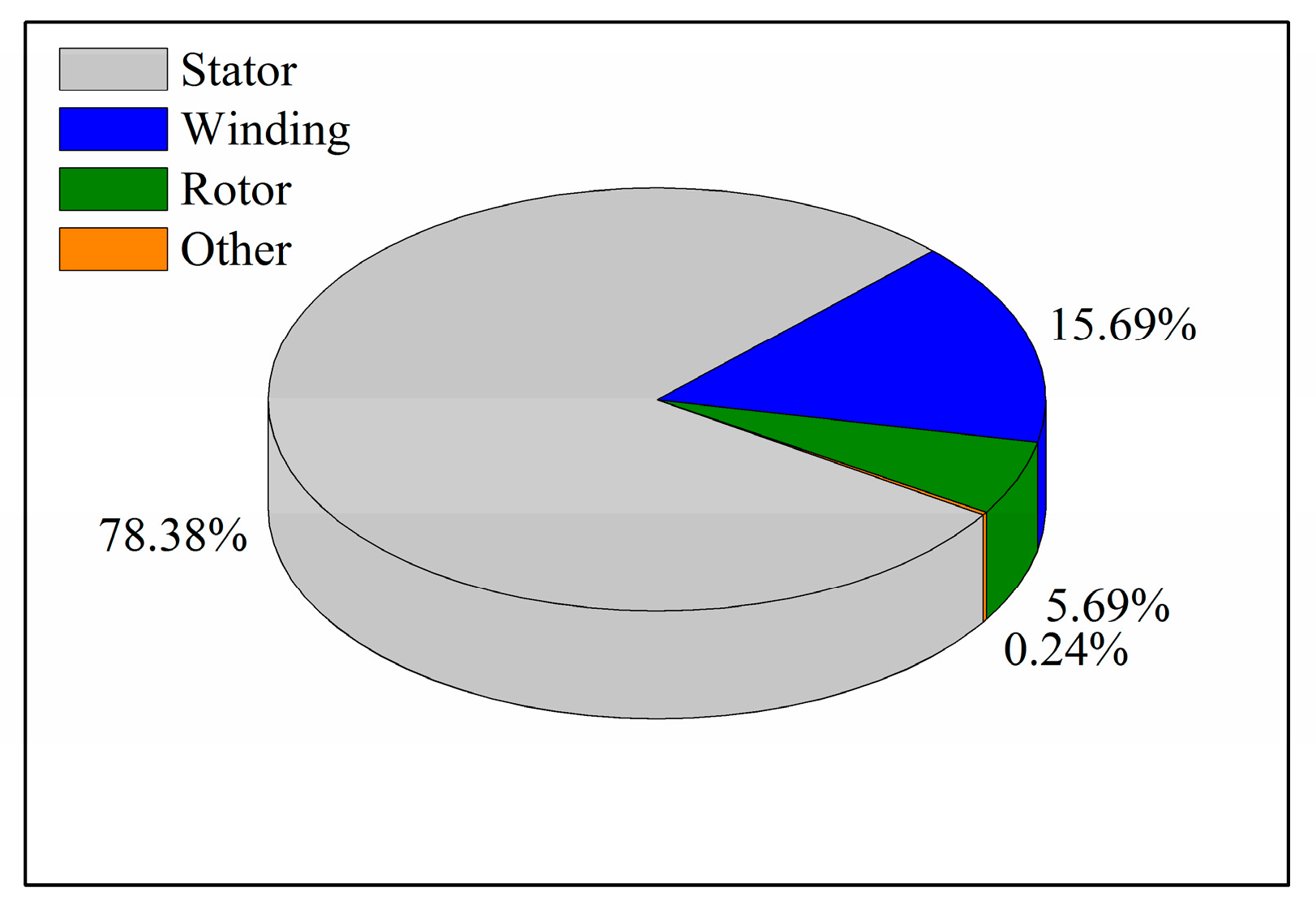
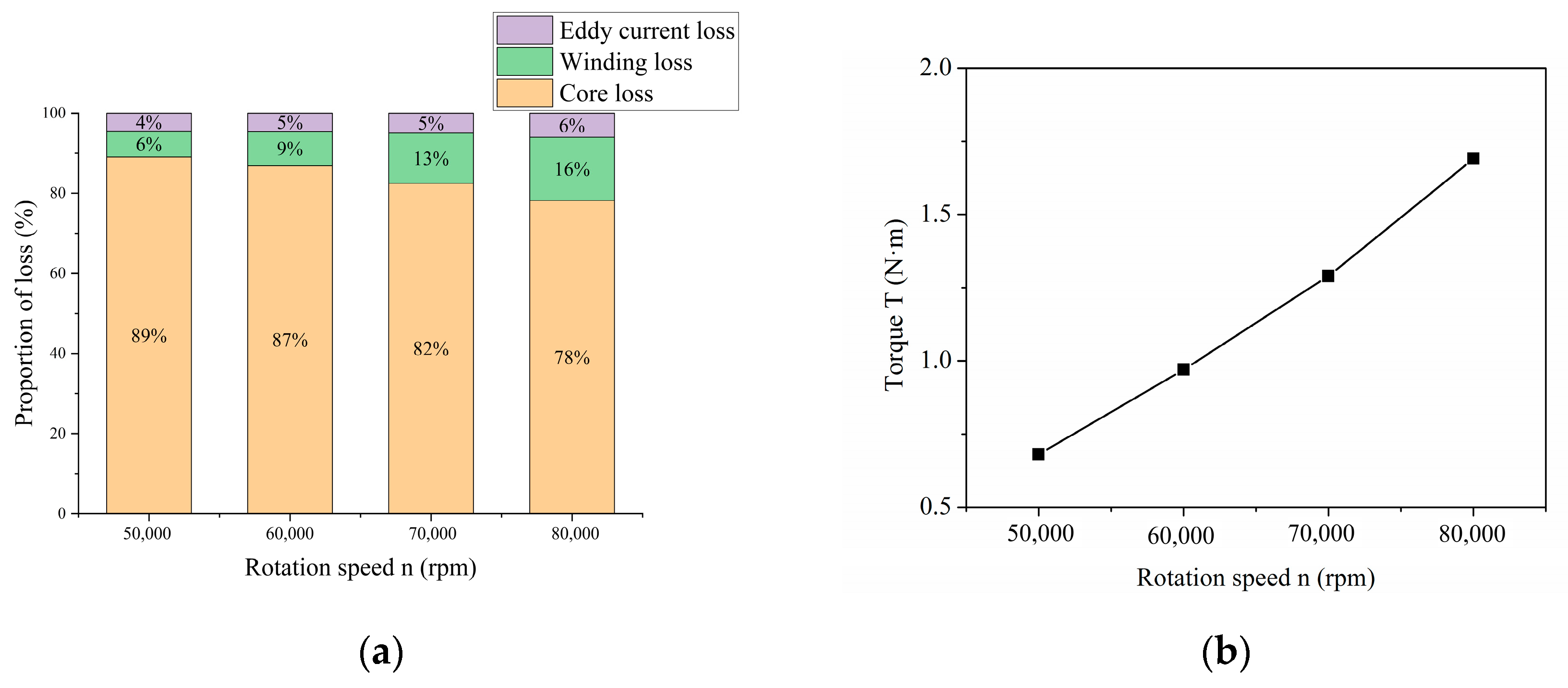
| Physical Quantity | Numerical Value |
|---|---|
| Outer diameter of spindle r (mm) | 20 |
| Inner diameter of spindle r1 (mm) | 12.5 |
| Outer diameter of thrust bearing r2 (mm) | 29 |
| Air gap of spindle δ (mm) | 3 |
| Air gap of air bearing δ1 (mm) | 0.03 |
| Length of spindle outer diameter l (mm) | 119 |
| Length of spindle inner diameter l1 (mm) | 15 |
| Radial length of bearing lr (mm) | 25 |
| Thickness of thrust disc lt (mm) | 5 |
| Density of air ρ (kg/m3) | 1.205 |
| Dynamic viscosity of air μ (kg/(m·s)) | 18.1 × 10−6 |
| Parameter | Numerical Value |
|---|---|
| Number of grooves | 18 |
| Number of poles | 2 |
| Outer radius of stator | 50 mm |
| Radius of rotor core | 16 mm |
| Length of stator and rotor core | 58 mm |
| Loss Coefficient | Numerical Value |
|---|---|
| kh | 80.85 |
| kc | 0.24 |
| ke | 6.47 |
| Revolutions/rpm | p1/kW | T/N·m | η/% |
|---|---|---|---|
| 50,000 | 3.20 | 0.61 | 93.11 |
| 60,000 | 5.58 | 0.88 | 94.38 |
| 70,000 | 8.69 | 1.19 | 95.12 |
| 80,000 | 13.00 | 1.55 | 95.62 |
| Components | Loss | Numerical Value/W |
|---|---|---|
| Basic loss | Iron loss of stator | 322.6 |
| Copper loss of winding | 64.6 | |
| Eddy current loss of rotor | 23.4 | |
| Eddy current loss of other alloys | Bearing | 9.4 × 10−6 |
| Rotating shaft Diffuser Cooling waterways Shell | 6 × 10−3 8.3 × 10−4 6.6 × 10−3 0.33 | |
| Sum | 410.93 |
Disclaimer/Publisher’s Note: The statements, opinions and data contained in all publications are solely those of the individual author(s) and contributor(s) and not of MDPI and/or the editor(s). MDPI and/or the editor(s) disclaim responsibility for any injury to people or property resulting from any ideas, methods, instructions or products referred to in the content. |
© 2023 by the authors. Licensee MDPI, Basel, Switzerland. This article is an open access article distributed under the terms and conditions of the Creative Commons Attribution (CC BY) license (https://creativecommons.org/licenses/by/4.0/).
Share and Cite
Yu, B.; Wang, F.; Liu, H.; Zhang, Z.; Chen, Y. Research on Motor Rotor Loss of High-Speed Air Compressor in the Application of Hydrogen Fuel Cell Vehicle. Processes 2023, 11, 475. https://doi.org/10.3390/pr11020475
Yu B, Wang F, Liu H, Zhang Z, Chen Y. Research on Motor Rotor Loss of High-Speed Air Compressor in the Application of Hydrogen Fuel Cell Vehicle. Processes. 2023; 11(2):475. https://doi.org/10.3390/pr11020475
Chicago/Turabian StyleYu, Bo, Fei Wang, Hua Liu, Zhiping Zhang, and Yuhui Chen. 2023. "Research on Motor Rotor Loss of High-Speed Air Compressor in the Application of Hydrogen Fuel Cell Vehicle" Processes 11, no. 2: 475. https://doi.org/10.3390/pr11020475





